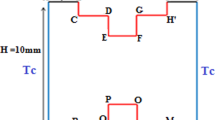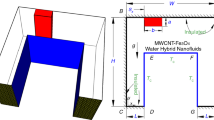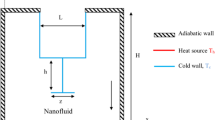Abstract
In the present study, using two-phase mixing method, the natural heat transfer (HT) in a nanofluid cavity is investigated by numerical method. The first phase is the water, and the second phase is the multiwalled carbon nanotubes. To investigate the various factors, numerical study on Rayleigh numbers (Ra) between 103 and 106 and nanofluid volume fraction (VF) range of 0–3% is performed. The effect of porous media is also investigated at Darcy numbers between 0 and 60. Results were presented through temperature contour, velocity contour, and mean Nusselt number (Nu) diagram. The results show that increasing the nanofluid VF will result in an improvement in HT and an increase in average Nu. As the Ra number increases and the convective term dominates, the nanofluid flow becomes turbulent, resulting in an increase in the average Nu number. At low Ra, due to the weak buoyancy force, the temperature lines will be almost the same shape as the cavity, but at Ra of 106, an increase in buoyancy forces will result in disrupting the uniform arrangement of the temperature lines. Using Taguchi method and signal-to-noise ratio, the order of importance of the parameters is investigated. Among the three different input parameters (Ra, VF, and porosity), the porosity or non-porosity of the medium is the most effective parameter on the average Nu number. Based on results, increasing Ra number will increase the average Nu number by 2300% for non-porous media and about 34–140% for porous mediums. Also, the maximum vertical velocity increases by about 249 times because of the increase in the Ra number.
Graphic abstract














Similar content being viewed by others
Abbreviations
- \(X\) :
-
Length (m)
- \(D\) :
-
Characteristic length (m s−1)
- \({\text{Ra}}\) :
-
Rayleigh number
- \({\text{Nu}}\) :
-
Nusselt number
- \({\text{Nu}}_{\text{avg}}\) :
-
Mean Nusselt number
- \(g\) :
-
Gravity acceleration
- \(T_{\text{h}}\) :
-
Hot temperature (k)
- \(T_{\text{c}}\) :
-
Cold temperature (k)
- Da:
-
Darcy number
- \(k\) :
-
Thermal conductivity (W m−1 k−1)
- \(c_{\text{p}}\) :
-
Specific heat (J kg−1 k−1)
- \(\alpha\) :
-
Emission factor (m2 s−1)
- \(\psi\) :
-
Flow function (kg s−1)
- \(\beta\) :
-
Thermal expansion coefficient (k−1)
- \(k\) :
-
Porosity coefficient
- \(\upsilon\) :
-
Kinematic viscosity (m2 s−1)
- \(\rho\) :
-
Density (kg m−3)
- \(\mu\) :
-
Dynamic viscosity (kg m−1 s−1)
- \(\theta\) :
-
Angle with horizontal line
- \(\varphi\) :
-
The volume fraction of nanoparticles
- f:
-
Base fluid
- nf:
-
Nanofluid
References
Choi SUS. Enhancing conductivity of fluids with nanoparticles. ASME Fluid Eng. 1995;231:99–105.
Esfe MH, Wongwises S, Naderi A, Asadi A, Safaei MR, Rostamian H, Karimipour A. Thermal conductivity of Cu/TiO2–water/EG hybrid nanofluid: experimental data and modeling using artificial neural network and correlation. Int Commun Heat Mass Transf. 2015;66:100–4.
Esfe MH, Arani AAA, Rezaie M, Yan WM, Karimipour A. Experimental determination of thermal conductivity and dynamic viscosity of Ag–MgO/water hybrid nanofluid. Int Commun Heat Mass Transf. 2015;66:189–195.
Esfe MH, Yan WM, Akbari M, Karimipour A, Hassani M. Experimental study on thermal conductivity of DWCNT-ZnO/water-EG nanofluids. Int Commun Heat Mass Transf. 2015;68:248–251.
Esfe MH, Saedodin S, Wongwises S, Toghraie D. An experimental study on the effect of diameter on thermal conductivity and dynamic viscosity of Fe/water nanofluids. J Therm Anal Calorim. 2015;119(3):1817–1824.
Esfe MH, Saedodin S, Mahian O, Wongwises S. Thermophysical properties, heat transfer and pressure drop of COOH-functionalized multi walled carbon nanotubes/water nanofluids. Int Commun Heat Mass Transf. 2014;58:176–183.
Esfe MH, Motahari K, Sanatizadeh E, Afrand M, Rostamian H, Ahangar MRH. 2016. Estimation of thermal conductivity of CNTs-water in low temperature by artificial neural network and correlation. Int Commun Heat Mass Transf. 2016;76:376–381.
Esfe MH, Rejvani M, Karimpour R, Arani AAA. Estimation of thermal conductivity of ethylene glycol-based nanofluid with hybrid suspensions of SWCNT–Al 2 O 3 nanoparticles by correlation and ANN methods using experimental data. J Therm Anal Calorim. 2017;128(3):1359–1371.
Esfe MH, Behbahani PM, Arani AAA, Sarlak MR. Thermal conductivity enhancement of SiO2–MWCNT (85: 15%)–EG hybrid nanofluids. J Therm Anal Calorim. 2017;128(1):249–258.
Esfe MH, Esfandeh S, Rejvani M. Modeling of thermal conductivity of MWCNT-SiO2 (30: 70%)/EG hybrid nanofluid, sensitivity analyzing and cost performance for industrial applications. J Therm Anal Calorim. 2018;131(2):1437–1447.
Esfe MH, Hajmohammad MH. Thermal conductivity and viscosity optimization of nanodiamond-Co3O4/EG (40: 60) aqueous nanofluid using NSGA-II coupled with RSM. J Mol Liq. 2017;238:545–552.
Esfe MH, Hajmohammad H, Moradi R, Arani AAA. Multi-objective optimization of cost and thermal performance of double walled carbon nanotubes/water nanofluids by NSGA-II using response surface method. Appl Therm Eng. 2017;112:1648–1657.
Esfe MH, Saedodin S, Biglari M, Rostamian H. Experimental investigation of thermal conductivity of CNTs-Al2O3/water: a statistical approach. Int Commun Heat Mass Transf. 2015;69:29–33.
Esfe MH, Arani AAA, Badi RS, Rejvani M. ANN modeling, cost performance and sensitivity analyzing of thermal conductivity of DWCNT–SiO 2/EG hybrid nanofluid for higher heat transfer. J Therm Anal Calorim. 2018;131(3):2381–2393.
Esfe MH, Hajmohammad MH, Razi P, Ahangar MRH, Arani AAA. The optimization of viscosity and thermal conductivity in hybrid nanofluids prepared with magnetic nanocomposite of nanodiamond cobalt-oxide (ND-Co3O4) using NSGA-II and RSM. Int Commun Heat Mass Transf. 2016;79:128–134
Esfe MH, Esfandeh S, Afrand M, Rejvani M, Rostamian SH. Experimental evaluation, new correlation proposing and ANN modeling of thermal properties of EG based hybrid nanofluid containing ZnO-DWCNT nanoparticles for internal combustion engines applications. Appl Therm Eng 2018;133:452–463.
Esfe MH, Zabihi F, Rostamian H, Esfandeh S. Experimental investigation and model development of the non-Newtonian behavior of CuO-MWCNT-10w40 hybrid nanolubricant for lubrication purposes. J Mol Liq. 2018;249:677–687.
Esfe MH, Rostamian H, Esfandeh S, Afrand M. Modeling and prediction of rheological behavior of Al2O3-MWCNT/5W50 hybrid nano-lubricant by artificial neural network using experimental data. Phys A: Stat Mech Appl 2018;510:625–634.
Esfe MH, Esfandeh S. Investigation of rheological behavior of hybrid oil based nanolubricant-coolant applied in car engines and cooling equipments. Appl Therm Eng. 2018;131:1026–1033.
Esfe MH, Reiszadeh M, Esfandeh S, Afrand M. Optimization of MWCNTs (10%)–Al2O3 (90%)/5W50 nanofluid viscosity using experimental data and artificial neural network. Phys A: Stat Mech Appl. 2018;512:731–744.
Esfe MH, Esfandeh S, Amiri MK, Afrand M. A novel applicable experimental study on the thermal behavior of SWCNTs (60%)-MgO (40%)/EG hybrid nanofluid by focusing on the thermal conductivity. Powder Technol. 2019;342:998–1007.
Esfe MH, Esfandeh S. Rheological behavior of CuO/EG: W (20: 80 v/v) nanofluid from a thermal perspective. J Therm Anal Calorim. 2019;135(1):61–72.
Esfe, MH, Esfandeh S, Niazi S. An experimental investigation, sensitivity analysis and RSM analysis of MWCNT (10)-ZnO (90)/10W40 nanofluid viscosity. J Mol Liq. 2019;288:111020.
Esfe MH, Arani AAA, Esfandeh S. Experimental study on rheological behavior of monograde heavy-duty engine oil containing CNTs and oxide nanoparticles with focus on viscosity analysis. J Mol Liq. 2018;272:319–329.
Esfe MH, Esfandeh S, Arani AAA. Proposing a modified engine oil to reduce cold engine start damages and increase safety in high temperature operating conditions. Powder Technol. 2019;2019(355):251–63.
Esfe MH, Arani AAA, Esfandeh S, Afrand M. Proposing new hybrid nano-engine oil for lubrication of internal combustion engines: Preventing cold start engine damages and saving energy. Energy. 2019;170:228–238.
Esfe MH, Arani AAA, Esfandeh S. Improving engine oil lubrication in light-duty vehicles by using of dispersing MWCNT and ZnO nanoparticles in 5W50 as viscosity index improvers (VII). Appl Therm Eng. 2018;143:493–506.
Esfe MH, Esfandeh S (2020) 3D numerical simulation of the enhanced oil recovery process using nanoscale colloidal solution flooding. J Mol Liq. 2020;301:112094.
Esfe MH, Hosseinizadeh E, Esfandeh S. Flooding numerical simulation of heterogeneous oil reservoir using different nanoscale colloidal solutions. J Mol Liq. 2020;302:111972.
Esfe MH, Saedodin S, Mahmoodi M. Experimental studies on the convective HT performance and thermophysical properties of MgO–water nanofluid under turbulent flow. Exp Therm Fluid Sci. 2014;52:68–78.
Esfe MH, et al. Thermal conductivity modeling of MgO/EG nanofluids using experimental data and artificial neural network. J Therm Anal Calorim. 2014;118(1):287–94.
Jahanshahi M, et al. Numerical simulation of free convection based on experimental measured conductivity in a square cavity using Water/SiO2 nanofluid. Int Commun Heat Mass Transf. 2010;37(6):687–94.
Esfe MH, et al. Applicability of artificial neural network and nonlinear regression to predict thermal conductivity modeling of Al2O3–water nanofluids using experimental data. Int Commun Heat Mass Transf. 2015;66:246–9.
Karimipour A, et al. Simulation of copper–water nanofluid in a microchannel in slip flow regime using the lattice Boltzmann method. Eur J Mechanics B Fluids. 2015;49:89–99.
Karimipour A, et al. Mixed convection of copper–water nanofluid in a shallow inclined lid driven cavity using the lattice Boltzmann method. Phys A. 2014;402:150–68.
Esfe MH, et al. An experimental study on thermal conductivity of MgO nanoparticles suspended in a binary mixture of water and ethylene glycol. Int Commun Heat Mass Transf. 2015;67:173–5.
Sheikhzadeh G, et al. Natural convection of Cu–water nanofluid in a cavity with partially active side walls. Eur J Mech B Fluids. 2011;30(2):166–76.
Esfe MH, et al. Study on thermal conductivity of water-based nanofluids with hybrid suspensions of CNTs/Al2O3 nanoparticles. J Therm Anal Calorim. 2016;124(1):455–60.
Ding Y, et al. HTof aqueous suspensions of carbon nanotubes (CNT nanofluids). Int J Heat Mass Transf. 2006;1–2:240–50.
Xie H, et al. Nanofluids containing multiwalled carbon nanotubes and their enhanced thermal conductivities. J Appl Phys. 2003;94:4967–71.
Liu M-S, et al. Enhancement of thermal conductivity with carbon nanotube for nanofluids. Int Commun Heat Mass Transf. 2005;32(9):1202–10.
Nazari S, Ellahi R, Sarafraz MM, Safaei MR, Asgari A, Akbari OA (2020) Numerical study on mixed convection of a non-Newtonian nanofluid with porous media in a two lid-driven square cavity. J Therm Anal Calorim, 140, 1121–1145.
Liu X, Toghraie D, Hekmatifar M, Akbari OA, Karimipour A, Afrand M (2020) Numerical investigation of nanofluid laminar forced convection heat transfer between two horizontal concentric cylinders in the presence of porous medium. J Therm Anal Calorim 1–14.
Mashaei PR, Shahryari M, Madani S. Numerical hydrothermal analysis of water-Al2O3 nanofluid forced convection in a narrow annulus filled by porous medium considering variable properties. J Therm Anal Calorim. 2016;126(2):891–904.
Belabid J, Belhouideg S, Allali K, Mahian O, Abu-Nada E. Numerical simulation for impact of copper/water nanofluid on thermo-convective instabilities in a horizontal porous annulus. J Therm Anal Calorim. 2019;138(2):1515–25.
Siavashi M, Joibary SMM. Numerical performance analysis of a counter-flow double-pipe heat exchanger with using nanofluid and both sides partly filled with porous media. J Therm Anal Calorim. 2019;135(2):1595–610.
Basak T, et al. Natural convection in a square cavity filled with a porous medium: effects of various thermal boundary conditions. Int J Heat Mass Transf. 2006;49(7–8):1430–41.
Baytas AC, Pop I. Free convection in a square porous cavity using a thermal nonEquilibrium model. Int J Therm Sci. 2002;41(9):861–70.
Grosan T, et al. Magnetic field and internal heat generation effects on the free convection in a rectangular cavity filled with a porous medium. Int J Heat Mass Transf. 2009;52(5–6):1525–33.
Saeid NH, Pop I. Transient free convection in a square cavity filled with a porous medium. Int J Heat Mass Transf. 2004;47(8–9):1917–24.
Mahmud S, Fraser RA. Magneto hydrodynamic free convection and entropy generation in a square porous cavity. Int J Heat Mass Transf. 2004;47(14–16):3245–56.
Braga EJ, de Lemos MJ. Turbulent natural convection in a porous square cavity computed with a macroscopic κ–ε model. Int J Heat Mass Transf. 2004;47(26):5639–50.
Prasad V, Kulacki F. Natural convection in a vertical porous annulus. Int J Heat Mass Transf. 1984;27(2):207–19.
Badruddin IA, et al. Numerical analysis of convection conduction and radiation using a non-equilibrium model in a square porous cavity. Int J Therm Sci. 2007;46(1):20–9.
Sathiyamoorthy M, et al. Steady natural convection flow in a square cavity filled with a porous medium for linearly heated side wall (s). Int J Heat Mass Transf. 2007;50(9–10):1892–901.
Misirlioglu A, Baytas AC, Pop I. Free convection in a wavy cavity filled with a porous medium. Int J Heat Mass Transf. 2005;48(9):1840–50.
Saeid N, Pop I (2005) Natural convection from a discrete heater in a square cavity filled with a porous medium. J Porous Media 8(1), 55-64.
Saeid NH. Natural convection in porous cavity with sinusoidal bottom wall temperature variation. Int Commun Heat Mass Transf. 2005;32(3–4):454–63.
Salari E, Peyghambarzadeh SM, Sarafraz MM, Hormozi F. Boiling thermal performance of TiO2 aqueous nanofluids as a coolant on a disc copper block. Period Polytech Chem Eng. 2016;122(2):106–22.
Sarafraz MM, Hormozi F. Convective boiling and particulate fouling of stabilized CuO-ethylene glycol nanofluids inside the annular heat exchanger. Int Commun Heat Mass Transf. 2014;53:116–23.
Sarafraz MM (2013) Experimental investigation on pool boiling heat transfer to formic acid, propanol and 2-butanol pure liquids under the atmospheric pressure, JOURNAL OF APPLIED FLUID MECHANICS (JAFM), 6(1), 73-79
Sarafraz MM, Arya H, Arjomandi M. Thermal and hydraulic analysis of a rectangular microchannel with gallium––copper oxide nano-suspension. J Mol Liq. 2018;263:382–9.
Sarafraz MM, Arjomandi M. Demonstration of plausible application of gallium nano-suspension in microchannel solar thermal receiver: experimental assessment of thermo-hydraulic performance of microchannel. Int Commun Heat Mass Transf. 2018;94:39–46.
Esfe MH, Afrand M, Esfandeh S (2020) Investigation of the effects of various parameters on the natural convection of nanofluids in various cavities exposed to magnetic fields: a comprehensive review. J Therm Anal Calorim, 140, 2055–2075.
Rostamian H, Lotfollahi MN. A novel statistical approach for prediction of thermal conductivity of CO2 by response surface methodology. Phys A Stat Mech Appl. 2019;527:121175.
Kamalgharibi M, Hormozi F, Zamzamian SAH, Sarafraz MM. Experimental studies on the stability of CuO nanoparticles dispersed in different base fluids: influence of stirring, sonication and surface active agents. Heat Mass Transf. 2016;52(1):55–62.
Siavashi M, Karimi K, Xiong Q, Doranehgard MH. Numerical analysis of mixed convection of two-phase non-Newtonian nanofluid flow inside a partially porous square enclosure with a rotating cylinder. J Therm Anal Calorim. 2019;137(1):267–87.
Lee J, Mudawar I. Assessment of the effectiveness of nanofluids for single-phase and two-phase HTin micro-channels. Int J Heat Mass Transf. 2007;50(3–4):452–63.
Sheikholeslami M, et al. Effect of thermal radiation on magnetohydrodynamics nanofluid flow and HT by means of two phase model. J Magn Magn Mater. 2015;374:36–43.
Behzadmehr A, Saffar-Avval M, Galanis N. Prediction of turbulent forced convection of a nanofluid in a tube with uniform heat flux using a two phase approach. Int J Heat Fluid Flow. 2007;28(2):211–9.
Fard MH, Esfahany MN, Talaie M. Numerical study of convective HTof nanofluids in a circular tube two-phase model versus single-phase model. Int Commun Heat Mass Transf. 2010;7(1):91–973.
Huminic G, Huminic A. HT characteristics of a two-phase closed thermosyphons using nanofluids. Exp Thermal Fluid Sci. 2011;35(3):550–7.
Akbarinia A, Laur R. Investigating the diameter of solid particles effects on a laminar nanofluid flow in a curved tube using a two phase approach. Int J Heat Fluid Flow. 2009;30(4):706–14.
Eid MR. Chemical reaction effect on MHD boundary-layer flow of two-phase nanofluid model over an exponentially stretching sheet with a heat generation. J Mol Liq. 2016;220:718–25.
Sheikholeslami M, Rashidi M, Ganji D. Numerical investigation of magnetic nanofluid forced convective HTin existence of variable magnetic field using two phase model. J Mol Liq. 2015;212:117–26.
Khandekar S, Joshi YM, Mehta B. Thermal performance of closed two-phase thermosyphon using nanofluids. Int J Therm Sci. 2008;47(6):659–67.
Noie S, et al. HTenhancement using Al2O3/water nanofluid in a two-phase closed thermosyphon. Int J Heat Fluid Flow. 2009;30(4):700–5.
Mirmasoumi S, Behzadmehr A. Numerical study of laminar mixed convection of a nanofluid in a horizontal tube using two-phase mixture model. Appl Therm Eng. 2008;28(7):717–27.
White FM, Fluid mechanics book, (2011), McGraw Hill.
Incropera FP, DeWitt DP, Bergman TL, Lavine AS. Fundamentals of heat and mass transfer, vol. 997. London: Wiley; 2007. p. 1683–4.
Erturk E, Corke TC, Gökçöl C. Numerical solutions of 2-D steady incompressible driven cavity flow at high Reynolds numbers. Int J Numer Meth Fluids. 2005;48(7):747–74.
Oztop HF, Dagtekin I. Mixed convection in two-sided lid-driven differentially heated square cavity. Int J Heat Mass Transf. 2004;47(8–9):1761–9.
Daneshvar N, et al. Biodegradation of dye solution containing Malachite Green: optimization of effective parameters using Taguchi method. J Hazard Mater. 2007;143(1–2):214–9.
Author information
Authors and Affiliations
Corresponding author
Additional information
Publisher's Note
Springer Nature remains neutral with regard to jurisdictional claims in published maps and institutional affiliations.
Rights and permissions
About this article
Cite this article
Hemmat Esfe, M. Using a two-phase method for numerical natural convection simulation in a cavity containing multiwalled carbon nanotube/water. J Therm Anal Calorim 146, 757–773 (2021). https://doi.org/10.1007/s10973-020-09950-y
Received:
Accepted:
Published:
Issue Date:
DOI: https://doi.org/10.1007/s10973-020-09950-y




